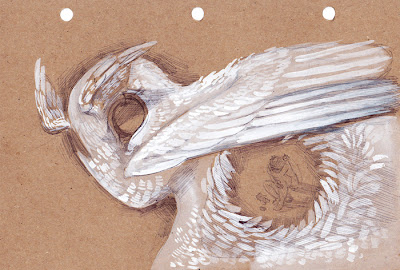"She had a great number of frogs in her throat."
"He was a monster athlete on the pommel horse, using strong arms that would be the envy of any gorilla."
This guy is first in the "monster athlete" series. Some of my athletes are more monster-like than others, but all are meant to bring to attention the incredible physical feats of these individuals. None are meant as a mockery, rest assured.
"He dove with the fluidity of a fish."
"He fired his bow like that of a skilled centaur."
"She jumped with the legs of a goat."
"Her movements on the bike were mechanical."
"She lifted the barbell with beastly strength."
Nope, this is not a metaphor. These are wing studies I did for my painting that I had begun and failed last week. I thought it would be good to see if wings in nature can be found in the same pose that I was going for.
This is further development of that painting. I went a new direction with it. I decided that I could not have the scene inside the apple like I was planning to do without having the "eye" be an extreme and somewhat cliche closeup. They had to be separated. There are a couple good things that came with doing that. The scene of the little girl is clearer, the composition has more energy, and I get to paint more wings. I can now proceed to making my maquette now!
These are anatomy studies from Bridgman's life drawing book that I sketched this morning to give my creative juices a break.




























